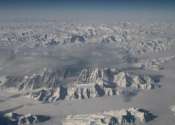Microbe study highlights Greenland ice sheet toxicity
The Greenland ice sheet is often seen as a pristine environment, but new research has revealed that may not be the case.

The Greenland ice sheet is often seen as a pristine environment, but new research has revealed that may not be the case.
Earth Sciences
Jul 10, 2017
2
392
In this month's special issue of Physics World, which examines the science and applications of invisibility, Martin McCall and Paul Kinsler of Imperial College London describe a new type of invisibility cloak that does not ...
General Physics
Jul 1, 2011
13
0

Students may soon be able to reach out and touch some of the theoretical concepts they are taught in their physics classes thanks to a novel idea devised by a group of researchers from Imperial College London.
Engineering
Dec 8, 2013
2
0
In this month's issue of Physics World, Jon Cartwright explains how the revelation that the US National Security Agency (NSA) is developing quantum computers has renewed interest and sparked debate on just how far ahead they ...
Quantum Physics
Jan 31, 2014
12
0

Life-threatening viruses such as HIV, SARS, hepatitis and influenza, could soon be combatted in an unusual manner as researchers have demonstrated the effectiveness of plasma for inactivating and preventing the replication ...
Plasma Physics
Dec 5, 2011
2
0

In light of recent results from the "world's longest experiment", spanning more than 90 years, at the University of Queensland, a group of researchers from Trinity College Dublin explain the background behind their own pitch-drop ...
General Physics
Apr 30, 2014
2
0

(PhysOrg.com) -- An astrophysics experiment in America has demonstrated how fundamental research in one subject area can have a profound effect on work in another as the instruments used for the Laser Interferometer Gravitational-Wave ...
Quantum Physics
Jul 16, 2009
5
0

Rembrandt and many other of the Old Masters may have used cutting-edge optics to aid their self-portraits.
Optics & Photonics
Jul 13, 2016
4
454
"The Search for Extraterrestrial Intelligence (SETI) has been dominated for its first half century by a hunt for unusual radio signals. But as he prepares for the publication of his new book The Eerie Silence: Are We Alone?," ...
Astronomy
Mar 1, 2010
1
0

Ceasing new oil, gas, and coal development is not enough—already built extraction facilities must be prematurely decommissioned—warns a new study released today in Environmental Research Letters.
Environment
May 17, 2022
22
314